“The Great Sabbath Day”
Teddy Roosevelt and the Sharon Springs Methodist Church
(This was written by Jayne Pearce, SSUMC Co-Lay Leader and Chair of the Ft. Wallace Memorial Association and Museum)
The morning of May 3, 1903 was clear and cold in Western Kansas. On the south end of the little cowtown of Sharon Springs, a small train of six cars sat at rest on a side rail. But Western Kansas had never seen the like of these gleaming Gilded-Age private cars, especially the final custom-built Pullman named the Elysian; “seventy feet of solid mahogany, velvet plush, and sinkingly-deep furniture. It had two sleeping chambers with brass bedsteads, two tiled bathrooms, a private kitchen run by the Pennsylvania Railroad’s star chef, a dining room, a stateroom with picture windows and an airy rear platform...” (Morris, 2001)
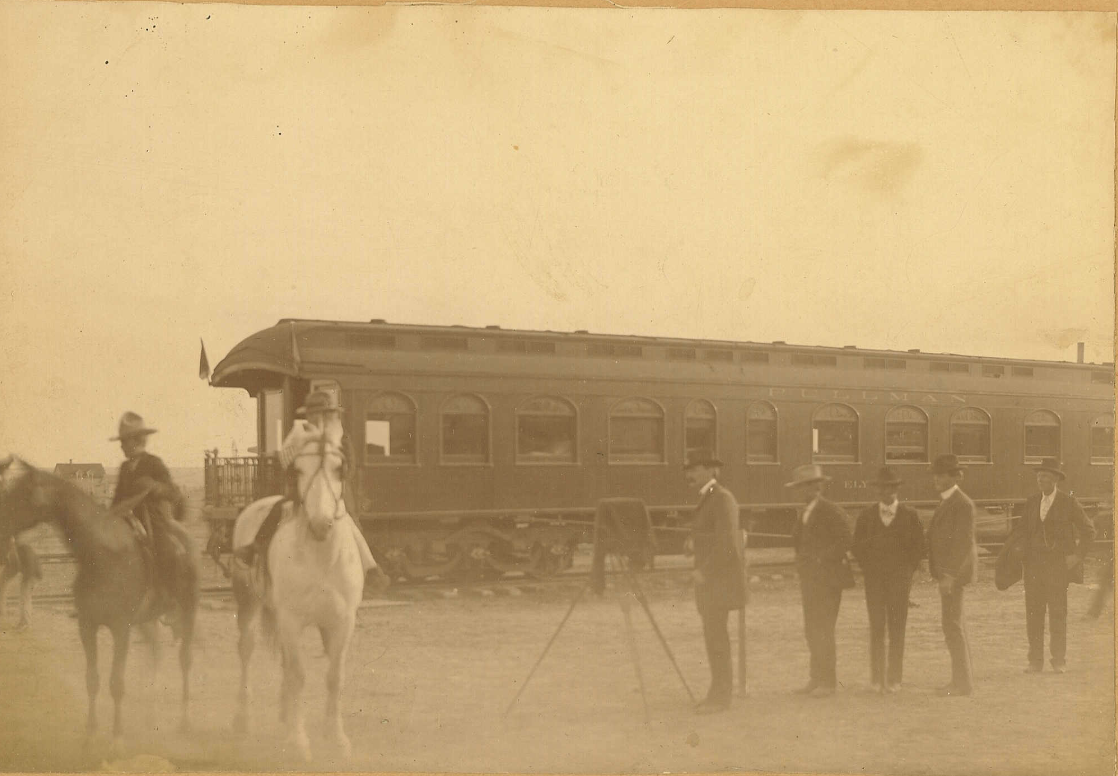
Elysian Pullman Car, Joe Langer for Denver Post, 1903
Although early on a Sunday morning, Sharon Springs fairly crackled with excitement. The little town of 170 souls had swelled to a population of nearly two thousand literally overnight; many had spent the night upright, as every bed, hayloft and floor space had been filled with a warm body. Savory smells filled the air, as every kitchen in town labored to feed the masses, as well as a very special guest.
A crowd of 200 old men made its way down Main Street – these “old soldiers” were veterans of the Civil War and had gathered from all over Western Kansas to greet and escort their guest of honor into town.
There was a flurry of movement in the back of the Elysian – the flash of white coats as the Pullman porters cleared the way- and down the back platform bounded the President of the United States, Theodore Roosevelt.
His movements were quick, sure and he moved with the deftness of a 16-year old. When greeted with the shouts of the old soldiers “Hurrah for the President! “Welcome to you, sir!” – the ruddy-complexioned burly man lifted his silk top hat and flashed his trademark grin of oversized and flawless white teeth.
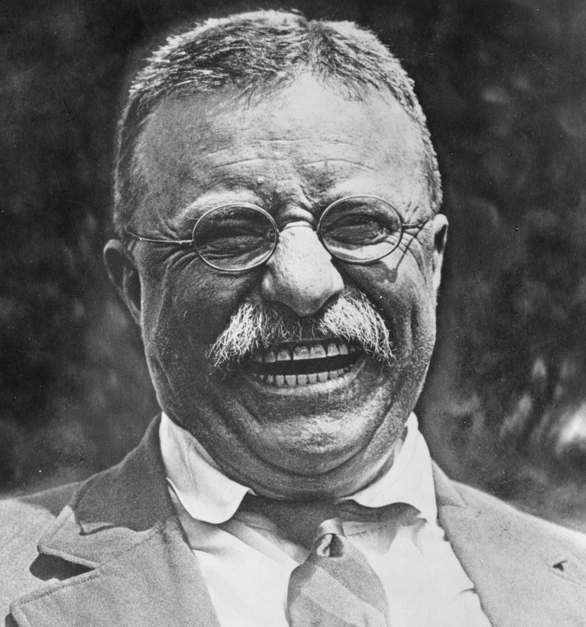
New York Times photo, 1915
The visit of Teddy Roosevelt - the President! The Rough Rider! – had been the subject of intense planning by the town of Sharon Springs ever since his desire had been expressed to spend a quiet 36 hours and attend church in a small town. Roosevelt was half-way through a tour of the American West which would take him 14,000 miles over 8 weeks, visiting 25 states, 150 towns and delivering 200 speeches. His visit had been planned, cancelled then re-affirmed. The Western Times newspaper had reported the forming of welcoming committees, the painting of the courthouse, the whitewashing of the fence and the clearing of the streets of the drunks. The Kansas City Star newspaper expressed confidence in the efforts of the town; “He will be furnished with a good feather bed if all the geese in Wallace County have to be plucked to make it.”
An important job for the committee was deemed to be the planning of a church service worthy of a U.S. President. Roosevelt was raised in the Dutch Reformed Church; as a young man, he had often taught Sunday School while living in New York City and he attended church services on a regular basis. B.G. Hurlburt was dispatched to Topeka to rent a tent to accommodate the masses, as no church in town was large enough for the anticipated crowds. However, word was received by telegraph – the President did not like the idea of the tent meeting and wished for a quiet service in a local church building. Post haste, the tent was returned to Topeka and the recently bricked Methodist Church was selected as the service venue. The celebrated preacher Rev. H.H. Carter of the 1st Presbyterian Church of Kansas City was secured as the guest speaker – only the very best in Kansas would do for the President’s Sunday.
In spite of a tremendous late-spring blizzard on Wednesday, the preparations were complete for this red-letter Sabbath day. President Roosevelt strode away from the train at his usual quick pace, accompanied by U.S. Senators Burton and Long of Kansas. The Senators were quickly learning of the President’s penchant for brisk, sometimes violent exercise; the night before, they had accompanied Roosevelt on a hike across the short-grass prairie. On return, Senator Long had commented wearily “We must have walked twenty miles.” “More than ten,” added Senator Burton. “About five, I should say,” said the President.
As the President, Burton and Long strode north toward the Methodist Church they were followed by Kansas dignitaries, newspapermen, then the contingent of old soldiers and townspeople.
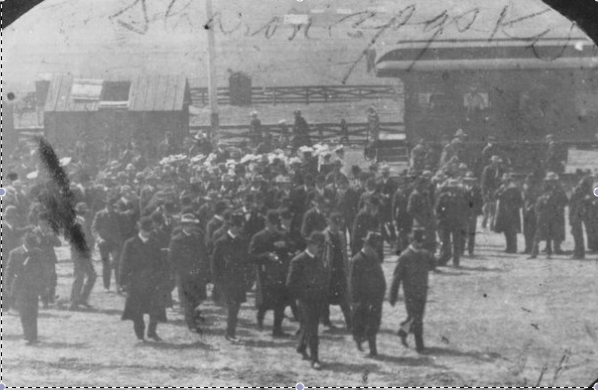
When he reached the church, the President bounded up the steps into the little building, stopping to greet the matrons whose receiving line awaited.
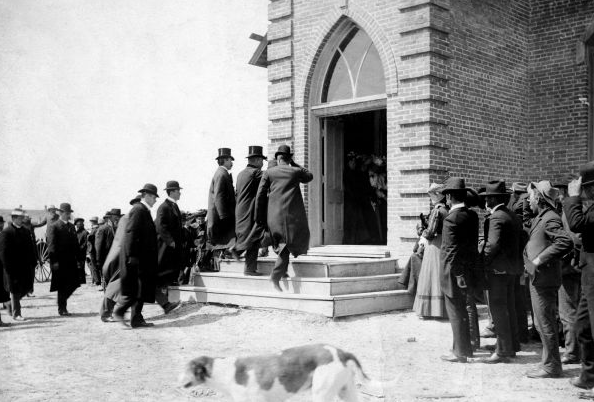
Photo by Joe Langer for the Denver Post, 1903
Six pews were reserved for the Presidential guest and entourage. “The newspapermen were grouped on the front seat. On the second seat were six old soldiers, and the President’s immediate party occupied the four remaining seats. The President sat in the fourth seat back. The first thing he did on coming into the church was to pick up the copy of Pentecostal Hymns which lay in the seat.” (Topeka Daily Capital, 1903)
The little church was packed to its capacity of 200, while up to 600 curious-onlookers crowded the churchyard. After the congregation was seated, a group of young girls came down the aisle in search of empty seats. There was room for all but two...Myrtle Coates and Anna Bracken. President Roosevelt, a father of six, invited the girls into his pew. After being seated, one of the girls touched the arm of Roosevelt and whispered, “Where’s the President?” As services began, the President offered to share his hymnbook with 13-year old Myrtle, who was dressed in her best pink calico dress and cherry blossom-trimmed hat, with “brown sunburned little arms and face that had been scrubbed till they almost shone.” (Morris, 2001)The congregation opened the service with the Doxology, then “All Hail the Power of Jesus’ Name” – the President singing along lustily in his high tenor voice.
An entire team of ministers had been assembled to participate in this country church service. The Methodist presiding elder of Western Kansas “a rugged, forceful, intelligent type of pioneer Methodist preacher” conducted the service. Rev. E.J. Stevens, pastor of the Christian Church of Goodland, offered the prayer. The Rev. John Wickstrand of the Swedish Lutheran Church of Assyria would offer the benediction. The Western Times would later observe “That eastern editor who thinks it is strange that a Lutheran President should listen to a sermon from a Presbyterian preacher in a Methodist church is respectfully informed that on the Western plains denominational lines are not drawn with geometric accuracy.” (Western Times, 1903)
The choir of twelve sang one simple anthem very well. “The basso end of the choir was very good and the organist played exceedingly well. She had nothing but a little cottage organ," intoned the big city Topeka Capital reporter. (Topeka Daily Capital, 1903) Pleasant surprise was reaction of the visitors when they were told that the musicians had been assembled solely from local talent.
The Topeka Capital reported on the fine message preached that day. The featured minister Rev. Carter spoke on 1st Corinthians 12. “He preached a masterly sermon, a little long perhaps, but showing a mind with a firm grip on the affairs of the world, impressive eloquence and flawless diction.” (Topeka Daily Capital, 1903)
Nowhere to be seen on the dais was the Sharon Springs Methodist pastor R.A. LeMaster. Church records do not reflect if he objected to being unceremoniously bumped from his own pulpit!
Even during the church service, the President was accompanied by his Secret Service, attired in grey overcoats and black bowler hats. It had been less than two years since the young Roosevelt had ascended the Presidency with the assassination of William McKinley; security was constant. In addition, Wallace County Sheriff G A Hays posted two guards – G.E. Woodhouse and G.E. Ward - at the front of the church for the protection of the President. The Western Times reporter wrote “Strangers who came into the church late kept asking which of the gentlemen was the President, the one with the cow-lick haircut or the one slightly bald.”
At the conclusion of the service, the President broke his previous protocol by expressing the desire to shake hands with all attending – “good feeling which prevailed at Sharon Springs” seemed to bring about a change of heart. The Secret Service men formed a line and the President began greeting the town. “Dee-lighted, sir!” and “By George”, was doubtless heard by the crowd as Roosevelt tirelessly shook hands.
Photo by Joe Langer for the Denver Post, 1903
When urged to return to the Elysian, the President laughed and said, ”No, these are my kind of people. I belong to the West, although I am a New Yorker. The census shows that Sharon Springs has a population of 170. I have shaken hands with 700, and I hope to meet the rest of them before I go.” (Topeka Daily Capital, 1903)
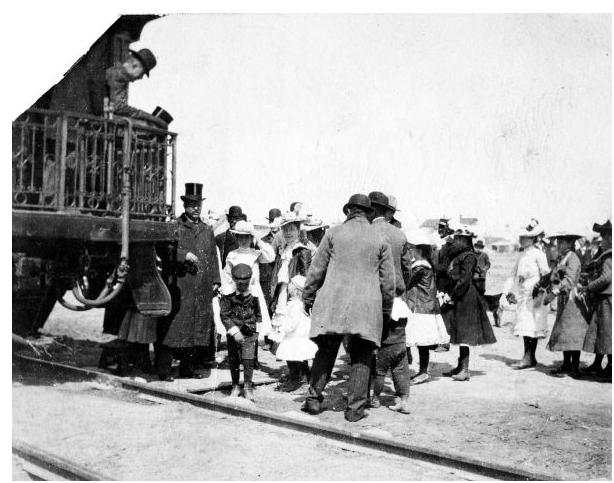
TR shaking hands w/children - Photo by Joe Langer for the Denver Post, 1903
(It is possible that the above photo was also taken in Sharon Springs! Same Denver Post Photographer, same Presidential clothing...)
Many of the visiting dignitaries and all out-of-town guests were fed in a number of makeshift restaurants located in every building on Main Street. It was reported that the lunches for 25 cents fit the bill, while the “get rich quick” establishments charging 50 cents were roundly condemned.
After lunch, Roosevelt was treated to a three-hour horseback ride, riding at breakneck speeds across the surrounding prairie. He was lent a chestnut sorrel mare belonging to S. A Chisum. Roosevelt reportedly vowed that he did not ride her hard, but Chisum family history states that the horse was in very poor condition after the Presidential outing!
Upon his return, a little girl named Pearl Gorsuch approached and asked if the President would like to have a baby badger. He said he would and a short time later the two-week old badger was delivered to the Presidential train. Teddy obligingly posed with the badger at the Sharon Springs trainyard, advising his little friend to “look pleasant”.
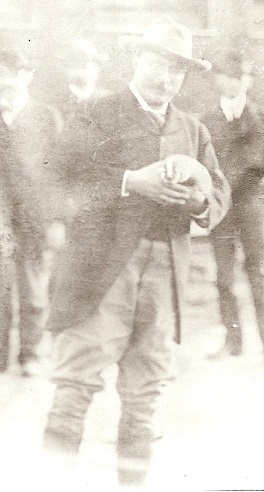
TR with Josiah at Sharon Springs Trainyard, photographer unknown
In exchange for the baby badger, Pearl and her friends got a private tour of the Elysian, as well as flowers and a medal. Josiah the badger (named for Pearl’s brother who had captured the animal) rode in the Presidential car for the remainder of the journey, hand-fed with potatoes and milk. Upon return to Washington, the badger joined the Roosevelt family’s famous White House menagerie. When he began to hiss and nip at the ankles of guests, Josiah was donated to the Bronx Zoo.
Before his Monday morning departure for Denver, the President expressed his gratitude for his refreshing visit. “You can tell the people of Sharon Springs and vicinity that I have enjoyed my visit immensely. The church service was simple and impressive, the sermon was fine, and the singing of the choir good...I had a corking good horseback ride. I had a corking good time." (Western Times, 1903)
Although the modern Sharon Springs United Methodist Church has changed locations, the pioneer spirit remains; they still can rise to occasions of offering hospitality to hundreds for weddings and funerals, can field a fine choir of local talent and go to great lengths to show Christ’s love to all comers. It is not difficult to imagine a modern-day President coming through the doors as a fellow worshipper. He would be told the same as countless other visitors through the years; “Please stay for church dinner – there’s plenty!”